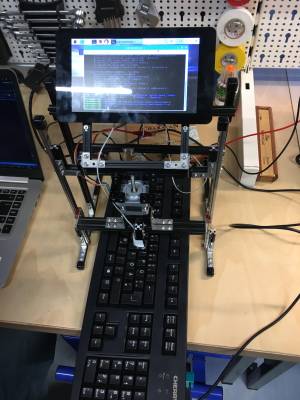Inhaltsverzeichnis
A non-invasive approach for measuring input device latency
Research in latency measurement is conducted since decades, but has ongoing relevance to users of input devices. Therefore we investigate a new approach to this topic. Bockes, Schmid and Wimmer [1] describe an invasive way to measure input latency for different types of devices. We pick up their idea and conduct experiments with the same devices but using a non-invasive approach. This means, that we focus on pressing a button of an input-device that is connected to a Raspberry Pi 2 via USB to trigger an input-event and measure the time it takes to arrive at the system. The button-press is achieved by a robot that physically triggers said button through the movement of a measuring head.
Members: Paul Winderl, Johannes Dengler, Thomas Oswald
Keywords: WIP, measuring, user study, input device, latency
A non-invasive approach for measuring input device latency: Method for input device latency measurement without irreversibly damaging the device.
This research project examines a way of non-invasive measurement of input device latency. To achieve this, we try to measure the pressure point of a input button and repeat a clicking mechanism to get latency data. After collecting those, we compare the result with an invasive approach that was used in a previous study.

Goals
The goal of this project is to examine the possibility of non-invasive latency measurement. We use an existing prototype that is to be enhanced by us.
A last approach used an invasive method to measure latency. This was done with the LagBox and a wired connection to the hardware of input devices [1].
However, invasive techniques are always connected with expense, time exposure and possibly an unrepairable hardware. Our approach tries to address these issues.
We are starting with an pressure sensor connected to a motor and a Raspberry Pi. The measurement works as follows: The sensor will be moved onto a button of a input device until it hits the pressure point which indicates a button press. We try to find this point and measure its latency from press to incoming signal at the usb driver.
Updates
Final Implementation and Measurements (2019-02-18)
This time we implemented last modifications and measured a couple of devices with this new software. Furthermore, we compared our solution with the PusherBox of another group. (more...)
More Testing (2019-02-04)
We are testing our calibration processes and overall measurement with different approaches. (more...)
Calibration, Measurement and Logging Files (2019-01-14)
Implemented functions for logging handled by two threads. (more...)
Testing and adjusting the calibration + a little gui (2018-12-18)
In this two weeks we have completed a new iteration of our calibration up and running. In a testing session we found minor enhancements and thought of a future roadmap. Furthermore, our GUI is still in development. (more...)
Implementation of the calibration process (2018-12-04)
Pressure point is now determined and tested for calibration. (more...)
The beginning of a life full of researching (2018-11-21)
This first article will inform about our start, the approach we take, our current status and a short outlook. (more...)
Further Resources
Literature [1] Bockes, F., Wimmer, R., & Schmid, A. (2018). LagBox – Measuring the Latency of USB-Connected Input Devices. In Extended Abstracts of the 2018 CHI Conference on Human Factors in Computing Systems (S. LBW115:1–LBW115:6). New York, NY, USA: ACM. https://doi.org/10.1145/3170427.3188632 [2] Manfrotto 035 Superclamp Universal Befestigungs-Mechanismus (Aluminium) schwarz. (n.d.). Retrieved January 17, 2019, from https://www.amazon.de/Manfrotto-Superclamp-Universal-Befestigungs-Mechanismus-Aluminium/dp/B000JLM4XG/ref=sr_1_6?s=ce-de&ie=UTF8&qid=1547708046&sr=1-6&keywords=fotoklemme